Biochemistry Additional Practice Chapter 3
1/7
There's no tags or description
Looks like no tags are added yet.
Name | Mastery | Learn | Test | Matching | Spaced |
|---|
No study sessions yet.
8 Terms
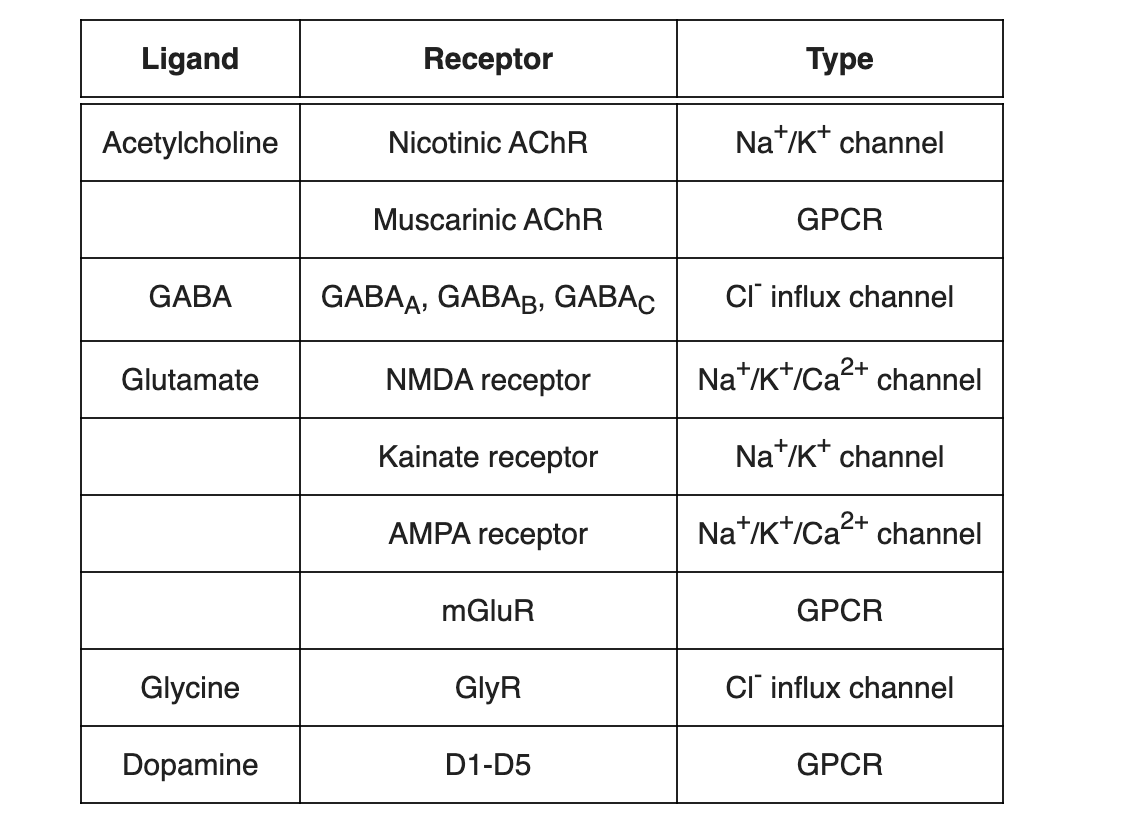
Passage
The electric ray, or the torpedo fish, has an electric organ rich in acetylcholine receptors (AChR). This organ is able to deliver a shock up to 200 volts for about 1 second. In order to discharge electricity from the cells of the electric organ, also known as electrolytes, the cells are stimulated by “pacemaker” neurons. When these neurons fire, acetylcholine is released onto the electrocytes, which causes a shock as a downstream effect. In the torpedo, the electric organs are located near the pectoral muscles and the gills.
The AChR in the electric organ are more specifically nicotinic AChR (nAChR). The nAChR are named for their agonistic response to nicotine. nAChR are ionotropic receptors because they are directly linked to ion channels and do not utilize second messengers. Metabotropic receptors, on the other hand, such as muscarinic AChR, form G protein-coupled receptor complexes in cellular membranes. In the torpedo, the nAChR opens in response to higher concentrations of acetylcholine.
Separately from the various acetylcholine receptors,the GABA receptor opens in response to the molecule gamma-aminobutyric acid and allows for the influx of chloride. Table 1 (below) includes a list of some major biological channels.
Table 1
A scientist isolates a particular mutant-type AChR found in certain species of torpedoes and obtains the following data for membrane current versus voltage (Figure 1) and acetylcholine concentration (Figure 2)
Figure 1
BLANK
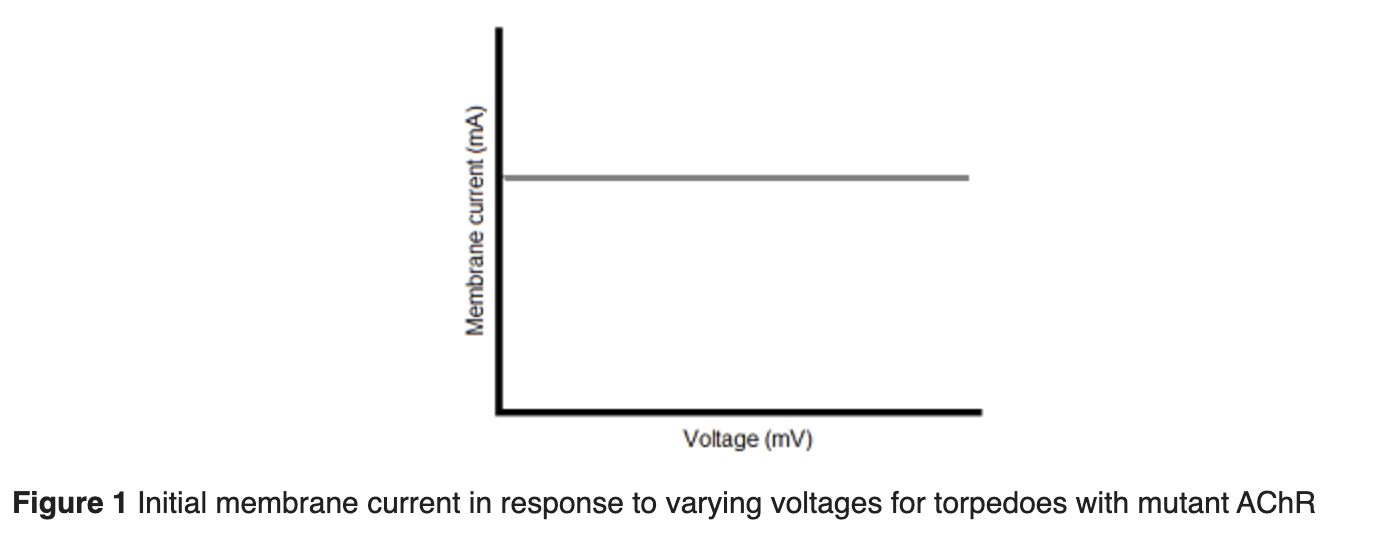
Figure 2
BLANK
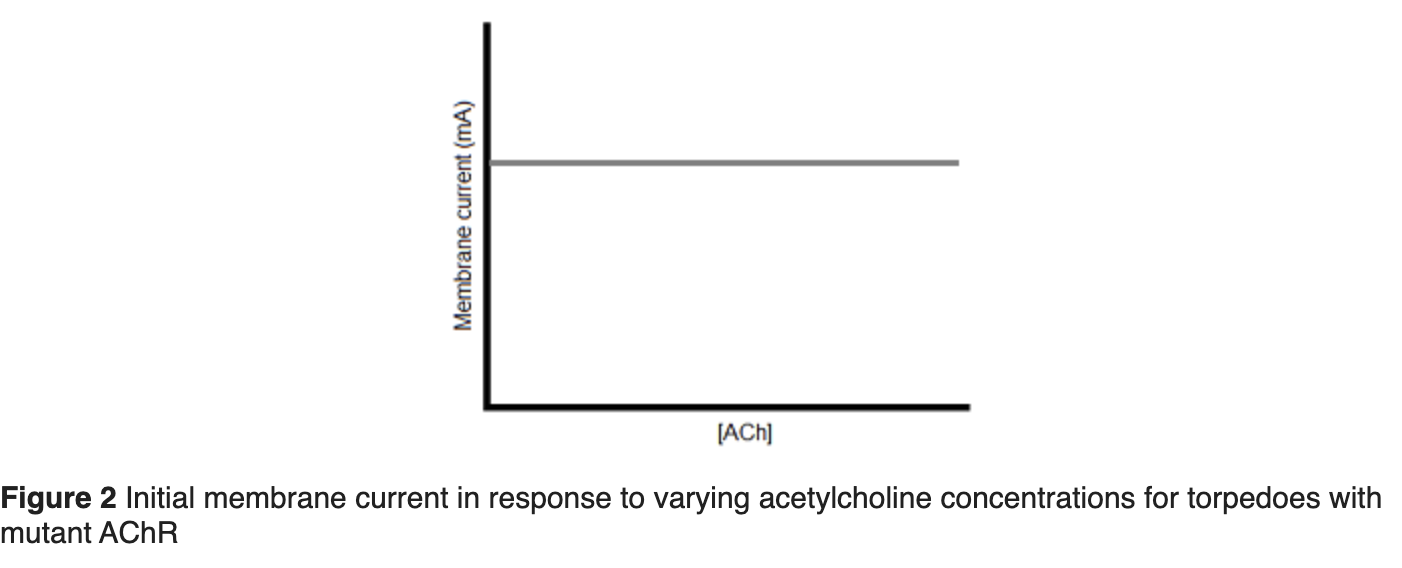
Based on the two figures in the passage, which of the following best describes the mutant channel?
A. Voltage-gated
B. Ligand-gated
C. Metabotropic
D. Ungated
D. Ungated
Explanation: Step by Step
Simplify the question
We can break this question down into two steps. In the first step, we must ask: What do the figures tell us about the nature of the mutant receptor?Armed with this information,we can more concretely predict: What type of receptor would most likely behave this way?
What is known? Unknown?
·Voltage-gated channels-the gate is regulated by the membrane potential change near the channel
·Ligand-gated channels-open in the presence of a specific binding substances, usually a hormone or neurotransmitter
-Ungated channels-are always open
While we might know about metabotropic receptors from our content knowledge
What relevant information is provided in the passage?
Before examining the two figures in the passage which the question stem references, we should turn our attention to the characterization of metabotropic receptors. In paragraph two we learn that these receptors form G protein-coupled receptor complexes in cellular membranes...
Now let's examine the two figures.Paragraph four tells us that the graphs depict the membrane current versus voltage (Figure 1) and acetylcholine concentration (Figure 2) for mutant-type AChR:
What is your prediction?
From Figures 1 and 2, we see that the membrane current does not change with alterations in either voltage or acetylcholine concentration. Since the membrane current is non-zero,this must mean that the channel is open and allowing flow of ions. Since this happens regardless of the voltage or concentration of the ligand, it must always be open. This would make it an ungated channel, or (D).

The figure below shows the transport of two molecules, glucose, and aldosterone, across a membrane. What is the difference between the transport mechanisms of the two molecules?
A. Size is more important than charge when it comes to transport across a membrane.
B. Aldosterone transport is limited by the amount of aldosterone specific membrane receptor present.
C. The rate of glucose transport can only be increased at high concentrations with stimulation of translation and protein trafficking.
D. At low concentrations, aldosterone transport is irrespective of concentration
C. The rate of glucose transport can only be increased at high concentrations with stimulation of translation and protein trafficking.
Explanation: Step by Step
Simplify the question
This question is asking for the difference between aldosterone and glucose transport. The answer choices focus on transport across a cell membrane. Therefore,we can rephrase the question by writing out the graph in words: If a molecule\'s rate of transport increases proportionally to its concentration, how is it likely being transported across a membrane? If its rate increases hyperbolically, how is it likely being transported?
What is known? Unknown?
It is known that molecules that are able to move across biological membranes via simple diffusion are able to do so relatively uninhibited. This is because their transport does not depend on receptors becoming saturated. In these cases, the rate of transport increases as the concentration increases.
On the other hand, it is known that molecules that require receptors, such as glucose (via GLUT receptors) are more limited. As the concentration of the molecule being transported is low, the rate of transport will increase rapidly with an increase in concentration. Eventually, however, the receptors become saturated, at which point the transport rate will plateau.
What relevant information is provided in the passage?
There is no additional information required from the passage in order to answer this question.
What is your prediction?
It is known that the molecules that require receptors, such as GLUT receptors for glucose,will exhibit a rate of transport that will increase linearly until the receptors become saturated and the rate plateaus. Aldosterone, on the other hand, is hydrophobic and able to diffuse freely across the membrane.
Predict, therefore, that the correct answer will be consistent with the idea that glucose relies on transporters while aldosterone relies on simple diffusion. Of the answer choices,this prediction matches (C), as the only way to increase the rate of glucose transport is to increase the number of transporters (via protein synthesis).
The nAChR, responsive to acetylcholine, is almost equally permeable to sodium and potassium. Opening of the channel will lead to depolarization of the electrocyte membrane. Which of the following channel proteins would be ideal for counteracting the effects of activating the nAChR?
A. D2
B. AMPA receptor
C.GlyR
D.mGluR
C.GlyR
Explanation: Step by Step
Simplify the question
This question is asking for the ion channel that will counteract the the activation of nAChR. We are told in the question stem that activation of nAChR allows for the flow of sodium and potassium,resulting in depolarization. Therefore, the correct answer choice should be one that leads to hyper-polarization. The question could therefore be
What is known? Unknown?
Hyperpolarization refers to a change in the concentration of molecules across membranes that makes a membrane potential of a neuron more negative. On the other hand, depolarization leads to a more positively charged membrane potential.
We know that hyperpolarization is the result of an influx of negatively charged ions into the cells or efflux of positive cells outside the cell.
What relevant information is provided in the passage?
The passage provides information about various receptors and their type:
What is your prediction?
The receptor in question leads to depolarization of the cell via the sodium influx and potassium efflux.
In order to counteract this, select the receptor that would lead to hyperpolarization,either through influx of a negatively charged ion or efflux of a positively charged one.According to the table, both the GABA receptors and the GlyR receptor allow for the influx of negatively charged chlorine ions. As GlyR is the only receptor represented in the answer choices, (C) is correct.
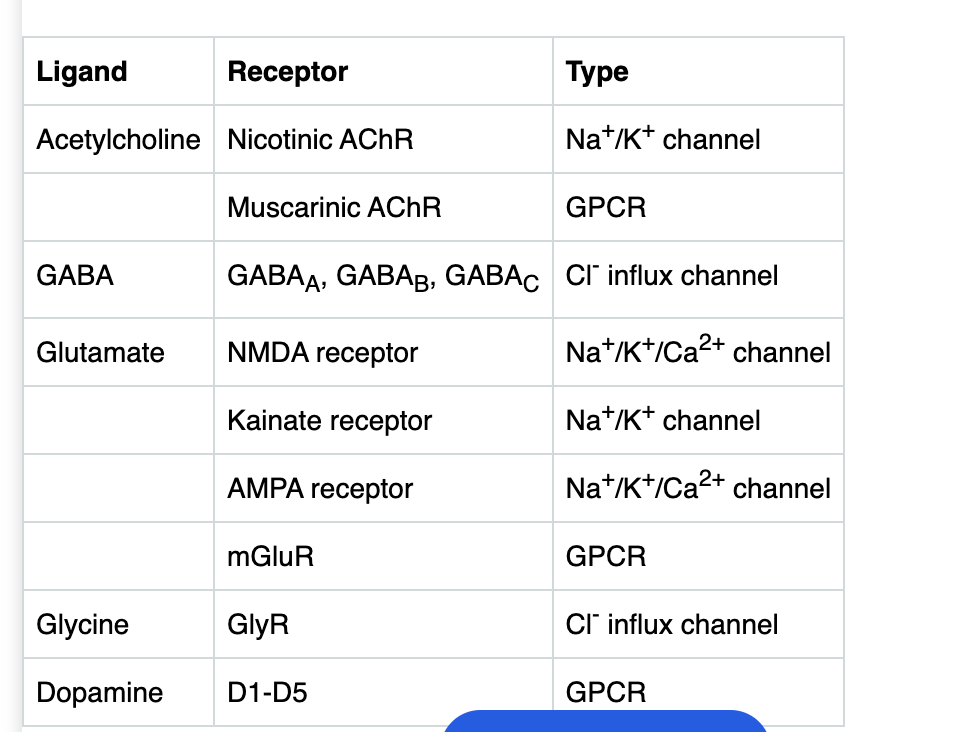
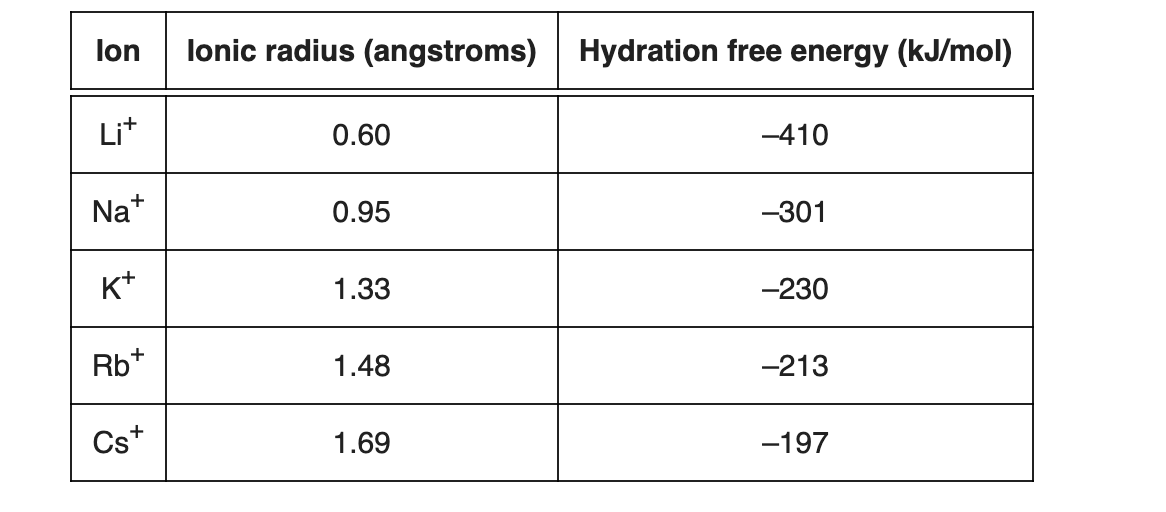
While the nAChR is about equally permeable to sodium and potassium, many channels are either Na+ or K+ specific. Given the following table, why might K+ leak channels be impermeable to sodium?
A. The hydration of sodium is less favorable than the hydration of potassium.
B. Potassium is able to lose another electron, unlike sodium, and become even smaller.
C. Sodium has a lower effective nuclear charge and thus interacts less favorably with the polar K+ leak channel.
D. The size of sodium precludes it from approximately interacting with the chains of the leak channel.
D. The size of sodium precludes it from approximately interacting with the chains of the leak channel.
Explanation: Step by Step
Simplify the question
This question is asking for the reason why K+ leak channels might be impermeable to sodium. The table provides a fair amount of information, but it can really be distilled to two important factors: sodium is considerably smaller than potassium, and sodium has a lower hydration free energy. With this in mind, the question can become: Why might sodium not interact with potassium leak channels: because sodium is smaller than potassium or because it has a lower hydration free energy?
What is known? Unknown?
We know that hydration free energy is the amount of energy that is released when one mole of an ion undergoes hydration. As ions travel down channels, they must be dehydrated. This means that those with lower hydration energies will actually require more energy to go through a channel.
It is also known that channels require a specific fit with their respective ions. If an ion is not the right size, it will not correctly interact with the side chains of a transporter and thus will not move through the channel correctly.
What relevant information is provided in the passage?
The passage does not provide any information that would be helpful in answering this question.
What is your prediction?
It is known that while hydration energy plays a role in the amount of energy required to allow an ion to travel through a channel, the energy difference between potassium and sodium is relatively small. However, their sizes are different: sodium is much smaller, which means it likely will not be able to interact properly with the side chains of the potassium leak channels well enough to allow passage through to the extracellular space.Predict that this will be the correct reason for why sodium is not able to move through the potassium leak channels. This prediction matches (D).
Which of the following is the mostly likely result of activation of muscarinic AChR?
A. Na+ influx-mediated depolarization
B. Inhibition of adenylate cyclase and a decrease in cAMP levels
C. Decrease intracellular calcium levels
D. Cl- influx-mediated hyperpolarization
B. Inhibition of adenylate cyclase and a decrease in cAMP levels
Explanation: Step by Step
Simplify the question
This question is asking for something that is true about the events that follow the activation of muscarinic ACh. This is a relatively broad question, so we can rephrase by breaking the question into two tasks: What type of receptor is a muscarinic AChR? Which of the following is consistent with how this general type of receptor works?
What is known? Unknown?
From the passage, we are told that muscarinic AChR is a G protein-coupled receptor.We know the mechanism of action for this type of receptor.
G protein-coupled receptors (GPCR) are a large family of integral membrane proteins involved in signal transduction. They are characterized by their seven membrane-spanning ⍺-helices.The receptors differ in specificity of the ligand-binding area found on the extracellular surface of the cell. In order for GPCRs to transmit signals to an effector in the cell, they utilize a heterotrimeric G protein. G proteins are named for their intracellular link to guanine nucleotides (GDP and GTP). The binding of a ligand increases the affinity of the receptor for the G protein. The binding of the G protein represents a switch to the active state and affects the intracellular signaling pathway. There are several different G proteins that can result in either stimulation or inhibition of the signaling pathway. There are three main types of G proteins:
·Gs stimulates adenylate cyclase, which increases levels of cAMP in the cell.
·Gi inhibits adenylate cyclase, which decreases levels of cAMP in the cell.
·Gq activates phospholipase C, which cleaves a phospholipid from the membrane to form PIP2.PIF is then cleaved into DAG and IP3; IP3 can open calcium channels in the endoplasmic reticulum, increasing calcium levels in the cell.
What relevant information is provided in the passage?
Paragraph two provides us with some information about the mechanism of action of a muscarinic AChR:
“Metabotropic receptors, on the other hand, such as muscarinic AChR,form G protein-coupled receptor complexes in cellular membranes.”
What is your prediction?
It should be predicted that muscarinic AChRs work via a second messaging system, given the fact that the passage tells us AChRs are G protein-coupled receptor complexes.This means that their activation can stimulate adenylate cyclase, inhibit adenylate cyclase, or activate